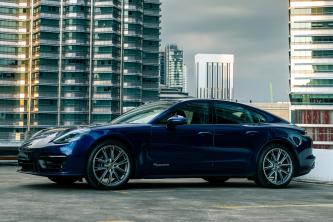intake manifold gif
Artikel Terkait intake manifold gif

New 2020 Toyota GR Supra for Malaysia - up RM 21k, 48 PS more and improved chassis
to 4,500 rpm previously.The engineers increased the power output by using a new dual-branch exhaust manifold
Spyshot: New 2020 Perodua Bezza facelift seen, launch imminent?
has been completely redesigned, featuring a pair of slimmer headlights and a more prominent lower air intake
Spied: New 2021 Proton Iriz MC2 facelift - upgraded infotainment, new round logo
MC2The bumper on the crossover is also noticeably more aggressive than the standard Iriz as the air intake
2020 Proton X50 has 2 turbo engines – one direct injection, one port, what’s the difference?
In this setup, fuel is injected into the intake port to be mixed with air before entering the combustion
70 percent of Perodua owners still return to an authorised service centre, even after warranty
For 2020, Perodua will maintain the same 67 percent target for its service intake, and to grow its after-sales
New Toyota C-HR unveiled, updated looks, quieter cabin
improved.Visually, the new Toyota C-HR gets a restyled front-end, featuring a more angular, prominent lower air intake
Ferrari is making different kind of intake valves to battle Covid-19
Toyota 4A-GE 16V/20V - legendary 'tofu delivery' engine, what makes them great?
Three reinforcement ribs on the back of the engine block.Image creditIn the Japanese versions, where a manifold
Mercedes-AMG GT R Pro: Ginormous HOOD?
Just like the vent that sits right above the stove in your kitchen, but for coll-air intake purpose rather
Engine braking is good for you, but how do you use it?
That creates a vacuum in the intake manifold.
Wearing a Cross-facia: 2020 Mitsubishi Pajero Sport Facelift
The new cars air intake grille is painted in black, which adds up a sense of dynamic for the front face
Drive68 body kit fitted to the 2020 Honda City
makeover with the Drive68 body kit.Up front, the front bumper extension gives off an aggressive visual intake
What on earth is VW’s Budack Cycle? It’s certainly not child’s play
A: The intake valve closes before the piston reaches BDC (Bottom Dead Centre) in the intake stroke, effectively
Volkswagen Adds New Aftersales Service - Walnut Blasting Decarbonizer
Over time, carbon deposits will accumulate into black soot that hardens around the intake valves, resulting
2020 Proton X50 - Confused with the features names? We explain the ABCs
In this setup, fuel is injected into the intake port to be mixed with air before entering the combustion
Tiny turbo engines: good or bad?
A: A turbocharger is a device that forces more compressed air into the intake port of the engine.Q: How
2019 Proton Persona , pricing from RM 42,600
RM49,600Persona Premium 1.6L CVT - RM 54,600Exterior, the new car has a new "Ethereal Bow" intake
HKS can now update the R32 Skyline GT-R's RB26 with modern tech, 600 PS and 5 L/100km?
highlighted in the RB26 Advanced Heritage are the: Pre-chamber combustion Vertical turbochargers Dual plenum intake
Should you clean your engine bay?
Unless you have leaves or anything else blocking the radiator or jamming your intake, you don’t
The VW ID.4 GTX is the electric, AWD Golf GTI you've been waiting for
GTX badging, high-gloss black air intake grilles, a black roof and rear spoiler, and an anthracite roof
Review Post intake manifold gif
@jfmezei Here's a GIF of how it works. Not included is the intercooler between the turbo and intake manifold (the long blue path on the right). It's basically a radiator that cools air instead of cooling liquids. I have two small ones in my car right at the front corners. https://t.co/9YIqjZvSm4
Review Q&A intake manifold gif
What does the 'V' mean in car engines (V6, V8, V12)?
It has to do with the cylinder arrangement. So what is a cylinder, and what types of arrangements are there? Let's start off describing what a cylinder is and how an engine works. First, here's an illustration showing a cross section of a cylinder in a typical car engine*: ABOVE: Typical Engine Cylinder with Various Parts Labeled SOURCE: ,Prem Sharma's answer to What is the name of IC engine parts? And here's an animated gif to give an idea of how it works. On the 1 stroke, as the piston moves down, it sucks the fuel/air mixture into the cylinder**. On the 2 stroke, it compresses the mixture. On the 3 stroke, the spark plug fires, igniting the fuel and forcing the piston back down. Note that this stroke is where ,all, the power comes from. On the 4 stroke, the burnt exhaust is pushed out of the cylinder. Then, the whole cycle repeats itself. ABOVE: Animation of a 4 Stroke Engine Cylinder SOURCE: ,Four-stroke engine - Wikipedia It is possible to have an engine with only one cylinder***. You'll just need a flywheel with enough inertia to keep the engine spinning during all the strokes when the cylinder isn't producing power. But, if you add more cylinders, and phase them so that they're on the power stroke at different times, you can make a smoother running engine with a more continuous power output and without needing as heavy of a flywheel. Every modern automobile I know of**** uses multiple cylinders. So, as you can probably imagine, there are various ways you can put multiple cylinders together to make an engine. Perhaps the most straightforward is simply lining them all up. This is known, appropriately enough, as an inline engine, or a straight engine. ABOVE: Diagram of a BMW Inline 6 SOURCE: ,Fotogalerie: BMW Concept 6 But inline engines are long. If the cylinders are offset, you can make the engine shorter. One such configuration is a flat or horizontally opposed engine (with the most common subtype being a boxer engine). These are common in airplanes, Subarus, the Porsche 911, and numerous other vehicles. ABOVE: Cutaway of a Subaru Horizontally Opposed Boxer Engine Image Source: ,Subaru of America Another option is to put all the cylinders in a ring around the crankshaft, known as a radial engine. These saw their hey day in old-school aircraft. Modern examples are mostly for people who want a new airplane that looks like an old one. ABOVE: Radial Engine SOURCE: ,flickr And to finally answer your question, you can arrange the cylinders in a 'V' formation. The engine can be less long and less tall than an inline engine, and less wide than a flat engine. The number in the name simply refers to the total number of cylinders. So, a V6 has 6 cylinders. A V8 has 8 cylinders. Etc. It's much easier to balance the engine (make it run smoother) when it has an even number of cylinders, so every V- engine I've ever heard of does have an even number of cylinders. If you're really curious, here's an article on engine balancing: The Physics of: Engine Cylinder-Bank Angles Since this is actually the type of engine you asked about, I'll provide a few more pictures for this one. ABOVE: A literal cutaway of a V8 enigne. The V-configuration of the cylinders is quite clear. Whoever cut this engine painted the intake plumbing in blue and the exhaust plumbing in red. SOURCE: ,Cutaway Hemi V8 Engine by Jetster1 on DeviantArt ABOVE: Illustration of a V6 engine showing all the internal components SOURCE: ,V6 engine - Wikipedia ABOVE: A V8 Engine Block. You can see how setting up the engine with 2 rows of cylinders allows the engine to be much shorter than if all 8 of those cylinders were in line. SOURCE: ,Bloco De Motor Do Mustang Fotos De Stock - Baixe 35 Fotos Royalty Free I hope that answers your question, and maybe taught you a bit about how engines work in general. The overall concept is pretty straightforward. Of course, like in many things, the devil’s in the details. Footnotes: *Cars are typically 4-stroke engines, which is what this answer addressed. There are also ,2-stroke engines, with a slightly different arrangement of intake & exhaust ports that let them generate power in 2-strokes instead of 4 (with various pros & cons to each configuration). **The traditional way of getting air and fuel into the cylinder is to mix them before the cylinder, either with a ,carburetor,, or with fuel injectors in the intake manifold. Either way, it was still a fuel air mixture getting sucked into the engine. Direct injection engines have been becoming more popular in recent years. In these, only the air is sucked in through the intake port. The fuel is added directly to the cylinder through the fuel injector. ***Single cylinder engines are still around. They see a lot of use in radio control models, tools, lawnmowers, and smaller vehicles like motorcycles, motorscooters, and go-karts. But most of those tend to be 2-stroke engines. ****One exception to pistons among automobile engines is ,rotary engines,, aka Wankel engines. Mazda was the leader in these engines, producing a variety of rotary powered RX- cars over the years, but they quit production of the RX-8 in 2012, and despite persistent rumors, it doesn't look like Mazda has another RX- car on the books anytime soon. Rotary engines have an entirely different configuration that doesn't use cylinders and pistons. But they still use multiple combustion chambers to keep the power output smooth.
What is the significant difference between a supercharger and a turbocharger?
Both compress air entering an internal-combustion engine, with the goal of increasing the amount of oxygen available in the fuel-air mixture that enters the cylinders, and thus increasing the amount of energy available to each power-stroke of each piston. A supercharger is direct-driven from the engine itself, typically by a toothed belt from the driveshaft, but occasionally directly from the driveshaft itself. The most common form is an external-compression, or ,Roots supercharger,, which uses counterrotating lobed “rotors” or gears to trap air (or fluid, in other uses) against the inside of an enclosure, and move it from one side to the other. Explaining this is the ,exact reason, animated gifs were invented: Those gifs are two-dimensional (well, three, with the third being time rather than Z, but..) the most common implementation uses three-lobe rotors which have a helical twist, in order to minimize pulsation or “hammering” of the output. It’s worthy of note that an “external-compression” supercharger does not actually compress air, it just pumps it from a low (atmospheric) pressure side to a high (intake manifold) side, where it’s compressed. The rate at which air that can be moved by a supercharger (or “blower” in the vernacular) is dependent upon the cross-sectional area of the void between the lobes and the enclosure, multiplied by the length of the rotors, multiplied by the rate of rotation. The more back-pressure you’re pumping against and the higher the rate, the more torque is required to turn the blower. On a top-fuel dragster, the supercharger typically ,consumes, 1,000 horsepower in the process of producing four atmospheres of pressure, which quadruples the amount of fuel (and fuel-air mixture) that can be combusted inside the cylinders, yielding a ,significant net gain in output horsepower,. These three photos of Roots superchargers being built (courtesy of ,Al’s Blower Drives, of Auckland) give a good sense of what the real thing looks like. Superchargers were instrumental in making high-altitude fighter-plane engines work in WWII, and were first mass-produced by General Motors for use on diesel trucks. Their two models, 4–71 and 6–71 became de-facto size standards (which allowed the production of interchangeable aftermarket parts), and Phil Weiand then began producing larger variants (8–71, 10–71, 12–71, 14–71) in the 1950s for racing use. Although in theory, you can use any size of blower on any size of engine, by adjusting the drive ratio between the crankshaft and the rotors, in fact there’s an efficiency “sweet spot” that dictates larger blowers on larger engines and smaller blowers on smaller engines: the faster the rotors are spinning, the more heat is generated and has to be dissipated. That heats the incoming air, which reduces its mass-per-volume, and causes the pump to work inefficiently or counterproductively. At the other end of the spectrum, the slower a Roots blower is turning, the more leakage there is between the tips of the rotors and the walls of the enclosure. There are two other types of superchargers: screw-type and centrifugal. The screw-type ones are very similar to Roots blowers, but use a progressively-tightening spiral, rather than a uniform helical spiral, in order to compress air (note that unlike Roots blowers, these only work on gaseous media, not incompressible fluid) within the blower; so they’re also called “internal compression” superchargers. They’re a better, more efficient design, but require much closer tolerances, which makes them more finicky, and much more difficult to maintain; not the best qualities in a race car, where the more common choice is to treat 14–71 blowers like popcorn, and just try to contain the popping under a kevlar blanket. Then there are centrifugal blowers, which spin a centrifuge to compress air. These require much higher rotational speeds to work, and aren’t nearly as efficient. Finally, we get to turbochargers, which are a pair of centrifuges running back-to-back on a common free-spinning shaft. The inlet of the turbine section takes exhaust gas which has been compressed by the exhaust stroke of the engine, and uses it to spin a turbine, which spins the shaft. The shaft in turn spins a compressor centrifuge, which pulls in atmospheric air, and compresses it into the intake manifold. The problems with this are many, most notably the “turbo lag” which is the relatively high latency between when the throttle is pressed (dumping in more fuel), higher exhaust pressure is achieved (spinning the exhaust turbine faster) and finally more air is pumped in (to provide more fuel/air mixture). But they’re cheap and easy to integrate (because all they need is ducting, no belts or shafts), so cheap Japanese cars and their derivatives tend to use them. I’m sure this will call the fury of ,ricer, trolls down upon me, but facts are facts. If turbos were useful in producing more horsepower, grownups who actually need more horsepower would use them. Instead, in racing and aerospace, you find pretty much exclusively superchargers. Mostly Roots-type.
Why didn't the rotary engine replace the piston engine?
Rotary Engine ,or ,Wankel Engine, is almost dead in the ,Automotive, sector and this is because of the various disadvantages of it. The Darwinian theory “,Survival of the fittest,” is even satisfied in the evolution of Engines. Disadvantage number 1: Because of its design, this engine has very low ,Thermal efficiency,. Due to this design, the engine has a very less ,compression ratio,. On observing the above GIF, you might be able to understand that the spark plugs will ignite the fuel, but the exhaust port which is beside the spark plugs will not be able to exhaust the complete burnt fuel, because of its shape. So, the ,burning ,fuel moves into the adjacent chamber and the partially burnt fuel escapes through the exhaust and the exhaust spits flames (this is why we see flames coming out more often of the cars which have rotary engines). So due to the incomplete combustion of the fuel, the efficiency is greatly reduced. Disadvantage number 2: Since the spark plug is present in one portion of the engine, there is a wide difference between the temperature at that portion and the other. Due to this, the portion of the engine where the combustion takes place has a temperature around 300 °C and at the other portion it would be some where around 100 °C. So, after prolonged usage, we might notice the expansion of metal due to this wide temperature difference. Due to the expansion at one side, the shape of the engine changes and so, mixing of burnt and un-burnt fuels takes place which lowers the efficiency of the engine. Disadvantage number 3: In this engine, oil is directly mixed into the combustion chamber! Yes, it is true! So, we have to check the oil levels frequently because technically, the engine is burning oil. It even enters into the intake manifold thereby manipulating the air fuel ratio hence, reducing the efficiency. So obviously the emissions are also going to be worse because of the oil. Disadvantage number 4: I personally feel this is the main reason why the rotary engine wasn’t able to replace the legendary piston engine, ,EMISSIONS. This really has terrible emissions. The amount of un-burnt hydrocarbons which regulate the ,Emission standards, of almost every country around the globe. I hope you now know why the ,Rotary engines ,failed in replacing the standard piston engines. Here is a bonus fact about ,Rotary engine. This engine was invented by ,Felix Wankel, when he was a ,Teenager!, I know you didn’t see this coming! Wait, how can I end this answer without getting ,Mazda RX7, into the topic. Though this beast is now out of production, this bad-ass car has left impressions in the ,Automotive industry. ,Present in almost all the racing game released between 1995–2008 this car dominated the ,IMSA-GTU, ,series for 10 bloody years between 1982 and 1992. This car is out of production from 2010, but is still in the hearts of many. P E A C E Hariharan Raju
 Beranda
Beranda 


